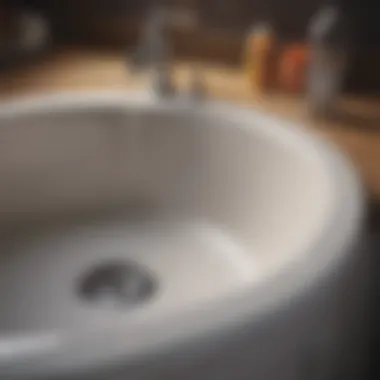Top Products for Unclogging Kitchen Sink Drains


Intro
A clogged kitchen sink is more than an inconvenience; it can lead to further complications, and sustained issues if left unresolved. Homeowners frequently grapple with these frustrating scenarios. Understanding the best products for unclogging a kitchen sink drain is vital. This guide aims to inform you about effective products and use scenarios. Also, it addresses safety concerns and preventative measures to maintain smooth plumbing.
In this exploration, you will learn how to tackle clogs with confidence. We will cover the most effective unclogging agents and give practical advice for keeping your drains in optimal condition. Let’s delve into the subject matter to ensure your kitchen remains a functional and inviting space.
Preamble
A clogged kitchen sink can become a significant inconvenience in any household. This situation not only interrupts daily routines but may also lead to potential plumbing issues if not addressed promptly. Understanding the different methods and products that can assist in unclogging drains is essential for efficient home management.
This article serves as a detailed guide, offering insights into various unclogging products and their effectiveness, as well as crucial safety considerations. Finding the best product to unclog a kitchen sink is not only about solving the immediate problem but also involves evaluating long-term implications on plumbing systems.
Many homeowners overlook proper maintenance and often resort to trial and error with various solutions. This can be frustrating and sometimes ineffective. By comprehensively discussing the types of clogging agents, their usage, and preventive measures, readers can make informed choices and enhance their plumbing's performance and longevity.
Thus, the significance of addressing kitchen sink clogs cannot be understated. Exploring the best products available can mitigate issues before they escalate and save time and expense in the long run.
Understanding Kitchen Sink Clogs
Understanding kitchen sink clogs is essential for anyone who frequently uses their kitchen. It lays the groundwork for addressing the issues that may arise from a clogged sink. A clogged drain affects daily routines and can lead to more severe plumbing problems if not managed. By recognizing the causes of clogs and the signs that signal a problem, homeowners can take proactive steps to avoid costly repairs.
Common Causes of Drain Clogs
Food Waste
Food waste is a significant contributor to clogged kitchen drains. When food particles, especially starchy substances like pasta or grains, are disposed of in the sink, they can settle and form accumulations that block the pipe. One key aspect of food waste is its variety. Items like vegetable peels, coffee grounds, and egg shells can all contribute to clogs. The more popular choice for disposal, food waste can lead to serious issues if regular maintenance is not performed. This characteristic underscores the importance of proper food disposal practices in maintaining an unobstructed kitchen sink.
Greasiness
Another common factor is greasiness. Cooking oils and fats can solidify inside pipes when they cool down, adhering to the surfaces and restricting water flow. Greasy residue is not always visible until it builds up significantly. This aspect of kitchen use highlights why being aware of how grease can affect plumbing is crucial. Maintaining clear drainage is often compromised by neglecting how residual grease can accumulate over time.
Foreign Objects
Foreign objects inadvertently finding their way into kitchen sinks is a frequent cause of clogs. Items like small utensils, food wrappers, and even small toys can obstruct water flow. The key characteristic of foreign objects is that they are often not intended to be in the sink. Once lodged, they can cause significant blockage. This unpredictability emphasizes that being vigilant about what is near the sink can prevent unwanted clogs.
Signs of a Clogged Drain
Water Backups
Water backups in the sink indicate a serious clog. When water fails to flow down the drain, it can result in flooding your kitchen. Often, this is the first noticeable sign of a problem. Water backups highlight the urgent need for intervention. Failing to address this issue may lead to more complicated plumbing problems.
Slow Drainage
Slow drainage often serves as an early warning sign. If water takes longer than usual to drain, it can signal the beginning of a clog. Slow drainage is a clear indication that something is obstructing the flow. Recognizing this symptom can prompt timely action.
Unpleasant Odors
Unpleasant odors from the drain may point to decomposing food debris or stagnant water. This can be a result of bacteria building up behind a clog. Odors are not only annoying but also signify a plumbing issue that needs addressing. Addressing unpleasant odors is vital for both hygiene and overall kitchen comfort.
Types of Products to Unclog Kitchen Sinks
Unclogging kitchen sinks is a common household need. Understanding the types of products available is crucial for effective and safe cleaning. Each solution has unique properties and advantages, along with considerations for use.
Chemical Drain Cleaners
How They Work
Chemical drain cleaners are formulated to dissolve clogs through powerful chemical reactions. Commonly, they contain caustic substances like sodium hydroxide or sulfuric acid. These components react with the materials causing the blockage, breaking them down into smaller particles. This method is beneficial for those looking to quickly clear a drain without manual intervention. However, the use of harsh chemicals can damage pipes, especially older ones, and should be approached carefully.
Advantages


One of the main advantages of chemical drain cleaners is their speed. They often deliver results much faster than other methods, which is beneficial for those in urgent need. They are also widely available and easy to use, requiring minimal preparation. These products can be effective against tough clogs, such as grease and food buildup.
Safety Concerns
While convenient, chemical drain cleaners come with significant safety concerns. They can emit harmful fumes and cause burns if they come into contact with skin. Additionally, improper use can exacerbate clogs, leading to potential pipe damage or more severe plumbing issues. It is critical to follow manufacturer instructions and use protective gear when handling these products.
Enzyme Cleaners
Mechanism of Action
Enzyme cleaners use biological processes to clear clogs. They contain natural enzymes that break down organic materials like food waste and grease into simpler components. This method of action is gentle on pipes and therefore is a popular choice for regular maintenance. Over time, consistent use can help reduce the buildup of materials that contribute to clogs, making it a sustainable option for homeowners.
Eco-Friendly Options
One of the key features of enzyme cleaners is their eco-friendliness. They are often made with safe, biodegradable ingredients that do not harm the environment. This can be particularly appealing to those who are environmentally conscious and prefer solutions that are less harmful than harsh chemicals. However, while these cleaners are safer for the environment, they can take longer to work than chemical solutions.
Effectiveness
The effectiveness of enzyme cleaners depends heavily on the type and extent of the clog. They work best with organic material but may struggle against tougher blockages from inorganic items. Users should consider their specific needs and possibly use these products in conjunction with other methods for optimum results. Tracking progress and combining approaches can lead to better overall drain health.
Manual Tools
Plumbing Snakes
Plumbing snakes are mechanical tools designed for clearing clogs. They consist of a long cable that can navigate through pipes, breaking apart clogs as it moves. Homeowners appreciate plumbing snakes for their ability to tackle stubborn blockages without the use of chemicals. This method can be a more hands-on approach, allowing for direct interaction with the problem rather than relying on a product to do the job.
Plungers
Plungers are one of the most basic yet effective tools for unclogging drains. By creating a vacuum and pressure, plungers can dislodge clogs with relative ease. They are widely available and require no special skills to use. A simple yet powerful tool, plungers can often resolve minor clogs before they escalate into larger issues.
Hydro Jetters
Hydro jetters use high-pressure water streams to clear blockages. They can be very effective for clearing out stubborn grease and debris buildup. However, they may require professional handling to operate safely. While they can clear out even tough clogs, the machinery involved may not be suitable for all households. This makes them more of a specialized tool for serious drain issues.
Comparison of Leading Unclogging Products
In the realm of kitchen maintenance, understanding the differences between various unclogging products is vital. Each product category–chemical drain cleaners, eco-friendly enzyme cleaners, and manual tools–offers unique methods and effectiveness levels. The key elements to consider include the specific type of clog, environmental impact, safety concerns, and ease of use. Homeowners who recognize these factors can make informed choices that align with their needs.
Various unclogging products come with their own advantages and downsides. For instance, chemical drain cleaners often work rapidly but may pose health and safety risks. On the other hand, enzyme cleaners provide a gentler approach but could require longer to show results. Manual tools like plungers offer a reliable hands-on method, but may not be suitable for all clog types. By comparing these products, one can tailor solutions to specific problems, ensuring effective management of kitchen sink maintenance.
Top Chemical Drain Cleaners
Product A
Product A is renowned for its aggressive formula designed to dissolve tough clogs quickly. The key characteristic of Product A is its ability to break down organic matter, grease, and food waste within minutes. This makes it a beneficial choice for users looking for immediate relief from stubborn blockages. One unique feature of Product A is its foaming action, which expands in the pipes to reach all areas of the clog. However, users must be cautious, as the harsh chemicals can be corrosive to pipes over time.
Product B
Product B is popular for its dual-action formula, which not only unclogs but also deodorizes the drain. Its key characteristic is that it combines both a liquid cleaner and powder for maximum effectiveness. This product is a wise choice for those concerned about unpleasant odors that often accompany clogged drains. A unique feature of Product B is its enzyme-based formulation, which helps prevent future clogs by maintaining a clean environment in the drain. However, its effectiveness may diminish if used frequently, requiring periodic replacement.
Product
Product C stands out due to its eco-friendly approach while maintaining effectiveness. The primary characteristic of Product C is its biodegradable formula, which breaks down organic waste without harming the surrounding environment. This makes it a popular choice for environmentally conscious homeowners. Its unique feature lies in its ability to work over time, helping to keep drains clear with regular use. But, the downside is that it might not be suitable for immediate relief of severe blockages, as it requires some time to take effect.
Best Eco-Friendly Enzyme Cleaners
Product
Product D is an enzyme cleaner that promotes ecological responsibility while offering a viable option for drain maintenance. The primary aspect of Product D is its method of using natural enzymes to break down organic materials in the drain. A key characteristic of this product is its non-toxic formula, making it an excellent choice for households with children or pets. Its unique feature is that it can be used regularly without the risk of pipe damage. However, users must understand that it takes longer to achieve results compared to chemical alternatives.


Product E
Product E is designed to tackle both clogs and odors simultaneously, boasting a strong focus on sustainability. Its main contributing factor is the use of plant-based enzymes that are effective in breaking down food particles and grease. This product is beneficial for households aiming for a greener lifestyle. The unique feature of Product E is its pleasant scent, offering a clean feel alongside its unclogging capability. On the downside, users may find that it requires more frequent application to maintain optimal drain health.
Product F
Product F operates as a concentrated formula aimed at reducing clogging in both kitchen and bathroom sinks. The focus on water conservation is one of its strongest points, making the product helpful for eco-conscious users. It is a valuable option for households looking to minimize their environmental footprint while maintaining effective drainage. A unique feature of Product F is its targeted action towards specific clogging substances like grease. However, because it is a concentrate, users must carefully follow dilution instructions for best results.
Step-by-Step Guide to Unclogging Your Sink
Clogs in kitchen sinks can be frustrating and disruptive. This section outlines a step-by-step guide, focusing on practical actions that homeowners can take. It emphasizes the benefits of methodical approaches to unclogging. Whether you opt for chemical cleaners or manual tools, knowing the right processes can save you time and effort.
Preparing the Area
Before you start addressing a clogged kitchen sink, it is vital to prepare the area adequately. This preparation minimizes potential mess and enhances safety during the unclogging process.
Clearing Nearby Items
Clearing nearby items is a critical step. It ensures that you're not working around obstructions that could become hazardous. This simple action allows for a more organized workspace, making it easier to manage tools and products. A clean area also prevents accidental damage to nearby items—plungers and chemicals can be messy. Moreover, it's easier to focus on the task at hand. Keeping the area clear can reduce time spent looking for tools.
Wearing Protective Gear
Wearing protective gear is another essential aspect of the preparation phase. While unclogging can seem straightforward, using chemicals or dealing with sludge can pose risks. Gloves and goggles provide safety against splashes and sharp edges, ensuring that you can work confidently. This choice highlights the importance of personal safety in potentially unpleasant situations. By safeguarding against injuries, you can proceed with peace of mind, thereby boosting efficiency.
Applying Chemical Drain Cleaners
Using chemical drain cleaners is a straightforward method to tackle stubborn clogs. However, understanding the application process is crucial for effectiveness and safety.
Dosage Instructions
Following proper dosage instructions is vital for effectiveness. Too much cleaner can harm pipes or create excess foam. Each product specifies the right amount to use, which enhances its efficiency. It’s also a straightforward method, easily understood and executed. This direct approach minimizes the risk of unintended damage from overuse, reinforcing the necessity of adherence.
Waiting Period
The waiting period after applying chemical cleaners can significantly influence the outcome. This time allows the solution to break down blockages effectively. Each product may have different recommendations, and respecting these timings is crucial. Sometimes, impatience leads to reapplication, which can be counterproductive. A little patience can make the process smooth and efficient.
Flushing the Drain
Flushing the drain is the final step after the chemical application. This action removes remaining residue and clears debris. Following the manufacturer's instructions for flushing ensures that all of the cleaner is washed away properly. Flushing not only enhances effectiveness but also reduces the risk of lingering chemicals. This step restores normal flow and can be satisfying, marking the end of a potentially tedious task.
Using Manual Tools
When chemicals fall short, manual tools can be invaluable. Using these tools often requires some technique but can prove very effective.
How to Use a Plunger
Using a plunger is a classic method for unclogging sinks. Firm, rhythmic thrusts can create the pressure needed to dislodge blockages. It's crucial to ensure proper sealing around the drain. This focuses the force upwards effectively. This method is widely regarded as highly effective and is an essential skill for any homeowner. Its accessibility and simplicity are key characteristics that make it an excellent option for unclogging.
Operating a Plumbing Snake
Operating a plumbing snake can be a bit more technical but is equally important. This tool is designed to navigate through pipes and dislodge tough clogs. Learning how to use one enhances your capability to tackle more severe issues. While it may seem daunting, the straightforward mechanics can be grasped with practice. Its effectiveness in reaching deeper obstructions amplifies its status as a popular choice among homeowners.
Preventative Measures for Clogs
Preventative measures play a crucial role in maintaining a clear kitchen sink drain. Addressing potential issues before they escalate saves time and money. Adopting these measures improves plumbing longevity and enhances kitchen hygiene.
Routine Maintenance Tips
Regular Cleaning


Regular cleaning of the sink and its drain is an essential practice. It prevents the build-up of food particles and grease, which commonly cause clogs. Ensuring a clean drain contributes positively to overall plumbing health. The key characteristic of regular cleaning is its simplicity. It requires minimal tools and effort but yields significant results.
One advantage of regular cleaning is its proactive nature. Homeowners can avoid serious drains issues before they start. This routine is often favored because it can be done on a schedule, making it a sustainable habit.
However, some disadvantages may arise. Individuals may neglect this task over time, leading to bigger problems. Keeping a consistent routine is vital to truly benefit from regular cleaning.
Avoiding Grease Build-Up
Avoiding grease build-up is another vital preventive measure. Grease, when washed down the sink, solidifies and can significantly obstruct drainage. This practice is important as excessive grease is among the leading causes of kitchen sink clogs. The key characteristic of avoiding grease build-up is learning the right disposal habits.
Using this method as a preventative tactic is beneficial. It reduces the need for costly unclogging products later. The unique feature is that education on proper disposal can have lasting effects on plumbing systems. Simple choices, like disposing of leftover cooking oils properly, can save much trouble.
One potential drawback is the initial effort required to change habits. It can be difficult for some to alter long-standing practices. Proper education is key in overcoming these challenges.
Best Practices for Drain Care
Using Drain Screens
Using drain screens is a straightforward and effective method to prevent clogs. They catch food particles before they enter the plumbing, protecting the drain’s integrity. This practice is popular because of its low cost and ease of implementation. The key characteristic of drain screens is their ability to be easily installed.
Drains screens have many advantages. They are reusable, easy to clean, and effective at blocking large debris. However, users must remember to empty the screen regularly to ensure it functions optimally. If neglected, overflow might happen, leading to additional clogs.
Disposing of Food Properly
Disposing of food properly is fundamental in maintaining a clear drain. This practice involves utilizing compost bins or trash for food waste instead of the sink. It is a beneficial choice because it prevents excess material from entering plumbing. The key characteristic of proper disposal is mindfulness in waste management.
One unique advantage of this practice is its environmental impact. By reducing what goes down the drain, homeowners contribute positively to waste management. But there can be challenges as well. Some individuals may find it inconvenient to separate waste, leading to resistance. Fostering awareness and motivating proper disposal habits is essential.
Keeping the kitchen sink free from clogs not only aids in daily routines but also enhances the lifespan of your plumbing system. By incorporating these measures, homeowners can save time and minimize potential frustrations.
When to Call a Professional
Addressing kitchen sink clogs can often be a manageable task, but there comes a point when the situation may surpass simple DIY efforts. Recognizing when to call a professional plumber is critical for preventing further damage and ensuring your plumbing system functions optimally. This section explores the signs and circumstances that indicate it is time to seek expert assistance.
Identifying Severe Clogs
Severe clogs can manifest in various ways. Homeowners may notice a combination of slow drainage and consistent backups that resisting common unclogging techniques. If you find yourself having to frequently apply drain cleaning products or relying on manual tools, it might be time to consider professional help.
Signs That DIY is Insufficient
Several symptoms indicate that the DIY approach is failing.
- Continuous Backups: Water consistently pools in the sink despite your attempts to clear it.
- Multiple Drains Affected: If other drains in your home are also slow, it suggests a more serious issue within the plumbing system.
- Unusual Noises: Gurgling or strange sounds coming from your plumbing can signal deeper problems.
These signs indicate a problem that is often beyond just a simple clog in the kitchen sink. The key characteristic here is that they illustrate a recurring issue. Relying on DIY methods could lead to more significant issues down the line, potentially requiring extensive repairs.
Potential Causes for Professional Attention
Understanding the potential causes for which you may need to call a professional is vital. These include:
- Tree Root Intrusion: Roots can infiltrate pipes, causing serious clogs that are difficult to remove without specialized tools.
- Pipe Damage or Corrosion: Aging pipes might be compromised, leading to breaks or disconnections that require professional assessment.
- Improper Installations: Sometimes, incorrect plumbing installations can lead to ongoing issues.
The main point here is recognizing that these underlying issues typically require a professional to address. Not catching them early can lead to larger plumbing issues, which may cost homeowners more money in the long run.
Overall, identifying severe clogs and knowing when to call a professional plumber can save time, stress, and money. It helps ensure that your plumbing system remains in good condition.
Ending
It is essential to understand the benefits of using expert-recommended products. High-quality chemical drain cleaners can quickly dissolve tough clogs, while enzyme cleaners offer an eco-friendlier alternative, breaking down organic material without harsh chemicals. Furthermore, understanding manual tools such as plungers and plumbing snakes enables homeowners to tackle minor issues before they escalate into more significant problems.
Preventative measures were also discussed. Regular maintenance practices can avert many plumbing problems. This includes disposing of food waste properly, cleaning drains routinely, and being mindful of what goes down your sink.
Effective drainage is not only about solving clogs as they arise. It is about forming habits that protect your plumbing system in the long run.
In summary, selecting the best product for unclogging and practicing preventative care leads to a more efficient plumbing system, reducing costs and inconvenience down the line. Being informed about these facts allows you to make better choices and take decisive action in maintaining your kitchen sink.







